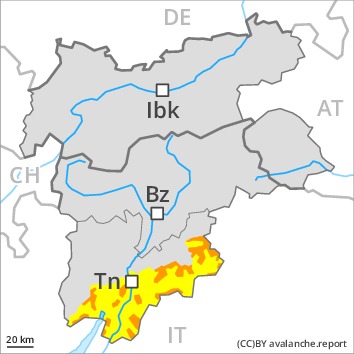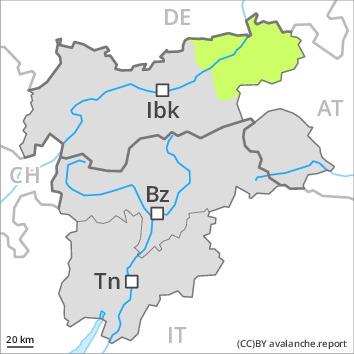
Danger level
 | 1600m
|
Avalanche Problem
 | | Persistent weak layer |
|  | |  |
 | | Wind-drifted snow |
|  | |  |

Weak layers in the upper part of the snowpack represent the main danger.
Dry avalanches can as before be released by small loads and reach large size in isolated cases. Small and medium-sized natural avalanches are, however, not entirely ruled out. Remotely triggered avalanches are possible. The avalanche prone locations are to be found in particular adjacent to ridgelines and in gullies and bowls, caution is to be exercised on steep slopes also below the tree line, as well as at the base of rock walls and behind abrupt changes in the terrain.
Whumpfing sounds and the formation of shooting cracks when stepping on the snowpack are a clear indication of a weakly bonded snowpack. In addition a latent danger of gliding avalanches exists. In the event of solar radiation this applies in particular on steep sunny slopes.
Ski touring and snowshoe hiking call for extensive experience in the assessment of avalanche danger and careful route selection.
Snowpack
Towards its surface, the snowpack is fairly homogeneous; its surface consists of loosely bonded snow. In some places new snow and wind slabs are lying on surface hoar. The avalanche prone locations are sometimes covered with new snow and are therefore difficult to recognise. The new snow and wind slabs of last week are bonding only slowly with the old snowpack in all aspects.
Faceted weak layers exist in the centre of the snowpack in particular on shady slopes. Towards its base, the snowpack is well consolidated.
Tendency
At elevated altitudes a precarious avalanche situation will still be encountered.

Danger level
 | treeline
|
Avalanche Problem
 | | Persistent weak layer |
|  | |  |
 | | Wind-drifted snow |
|  | |  |

Weak layers in the upper part of the snowpack necessitate caution. A treacherous avalanche situation will be encountered in some regions.
The near-surface layers of the snowpack necessitate caution and restraint. Dry avalanches can be triggered in the weakly bonded old snow and reach quite a large size. Remotely triggered avalanches are possible. Avalanche prone locations for dry avalanches are to be found on steep shady slopes, also below the tree line. The avalanche prone locations are covered with new snow and are barely recognisable, even to the trained eye. Especially places where surface hoar has been covered with snow are treacherous. Whumpfing sounds and the formation of shooting cracks when stepping on the snowpack serve as an alarm indicating the danger. Meticulous route selection is important.
The fresh wind slabs are mostly small but prone to triggering. These avalanche prone locations are to be found above the tree line, caution is to be exercised adjacent to ridgelines and in gullies and bowls.
As a consequence of solar radiation more dry snow slides and avalanches are possible as the day progresses.
In addition a latent danger of gliding avalanches exists.
Snowpack
dp.8: surface hoar blanketed with snow
dp.4: cold following warm / warm following cold
Faceted weak layers exist in the top section of the snowpack. The somewhat older wind slabs are lying on surface hoar in some places.
As a consequence of a moderate northerly wind, soft wind slabs formed. The fresh wind slabs are lying on soft layers. As a consequence of low temperatures the snowpack can not consolidate.
Towards its base, the snowpack is well consolidated.
Tendency
A precarious avalanche situation will persist. Gradual increase in avalanche danger as a consequence of the moderate northerly wind.

Danger level
 | 2000m
|
Avalanche Problem
 | | Persistent weak layer |
|  | |  |
 | | Wind-drifted snow |
|  | |  |

The current avalanche situation calls for experience in the assessment of avalanche danger.
A sometimes treacherous avalanche situation will prevail. This applies in particular in the south. Weak layers in the upper part of the snowpack can still be released in some place by winter sport participants in particular on steep sunny slopes. This applies in particular between approximately 2200 and 2600 m. Mostly the avalanches are medium-sized.
Also places where surface hoar has been covered with snow are unfavourable. Caution is to be exercised in particular on very steep shady slopes at transitions from a shallow to a deep snowpack, when entering gullies and bowls for example, also at intermediate altitudes.
Snowpack
dp.4: cold following warm / warm following cold
dp.8: surface hoar blanketed with snow
Faceted weak layers exist in the top section of the snowpack. This applies in particular on sunny slopes between approximately 2200 and 2600 m. The older wind slabs are lying on surface hoar in some places. Towards its base, the snowpack is well consolidated.
Tendency
Weak layers in the upper part of the snowpack necessitate caution.

Danger level
 | treeline
|
Avalanche Problem
 | | Wind-drifted snow |
|  | |  |
 | | Persistent weak layer |
|  | |  |

Individual avalanche prone locations for dry avalanches are to be found on very steep slopes above approximately 2300 m and adjacent to ridgelines.
In isolated cases avalanches can be triggered in the faceted old snow and reach medium size in some cases. This applies in particular on very steep shady slopes above approximately 2300 m, as well as at transitions from a shallow to a deep snowpack.
Fresh and somewhat older wind slabs are mostly shallow but in some cases prone to triggering. Caution is to be exercised in particular adjacent to ridgelines and in gullies and bowls.
Snowpack
dp.1: deep persistent weak layer
dp.7: snow-poor zones in snow-rich surrounding
Here only a little snow is lying. The snowpack is faceted. The fresh and somewhat older wind slabs are lying on top of a weakly bonded old snowpack. Faceted weak layers exist in the bottom section of the snowpack at high altitudes and in high Alpine regions.
Tendency
In some regions increase in avalanche danger as a consequence of the moderate to strong northerly wind.

Danger level

Low, level 1.
Individual avalanche prone locations for dry avalanches are to be found on very steep shady slopes above approximately 2000 m, especially adjacent to ridgelines. The avalanche prone locations are rare and are easy to recognise.
Snowpack
From a snow sport perspective, in most cases insufficient snow is lying. Hardly any weak layers exist in the snowpack.
Tendency
Low, level 1.















